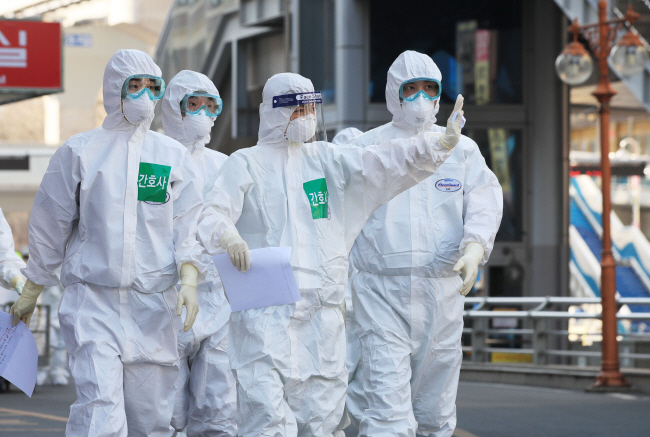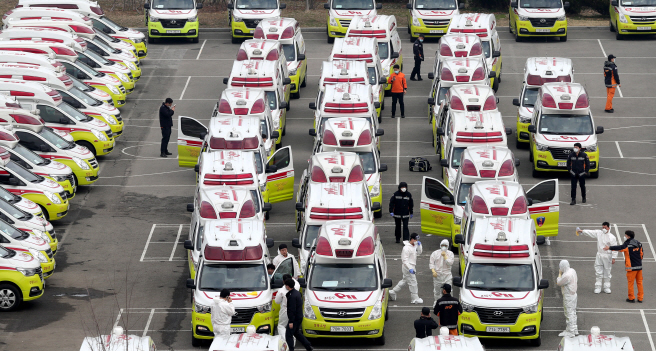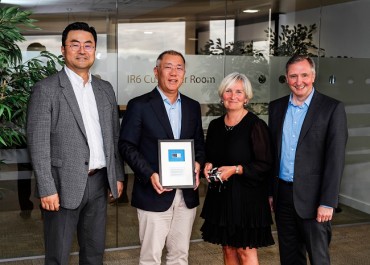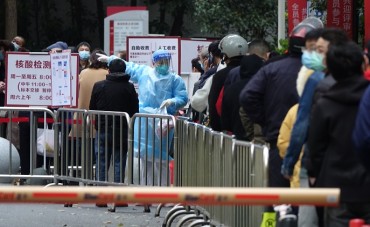
Medical staffers wave to reporters while entering Dongsan Hospital in the virus-hit city of Daegu for a work shift on March 24, 2020. (Yonhap)
DAEGU, Aug. 18 (Korea Bizwire) — It has been six months since the outbreak of the first coronavirus infection in Daegu.
Daegu, once known as one of the biggest coronavirus hotspots in the world, is now being commended as a successful model case for containing the pandemic, gaining the world’s attention.
As of Sunday, the total number of infections in the Daegu area hit 6,947 cases.
However, the rate of infection has been stabilized. Despite a series of coronavirus infections in the Greater Seoul Metropolitan Area, there have been almost no additional cases of infections reported in Daegu.
Daegu patients now comprise less than 50 percent of all coronavirus patients in the country currently being treated.
Daegu’s successful quarantine was only possible through the efforts of healthcare workers, firefighting agencies, volunteers, indiscriminate support for both domestic and foreign citizens, and close cooperation from local citizens.
Experts add that introduction of innovative methods to diagnose the infection was also a significant contribution.
Drive-through screening was first introduced by Chilgok branch of the Kyungpook National University Hospital to accommodate the overwhelming inflow of coronavirus patients caused by early screening methods, which were both expensive and slow.
The drive-through system drastically reduced the screening time while better ensuring the safety of the healthcare workers, allowing quick and accurate diagnosis.
This method soon gained the world’s attention. The United States, France, Germany, and others quickly followed suit.
Establishment of community treatment centers was also part of the idea to accommodate the massive inflow of coronavirus patients, to divide them based on the severity of the symptoms, and send only those in dire need of treatment to hospitals.

Ambulances are parked outside a water purification plant in Daegu on March 1, 2020, with emergency workers checking their vehicles. (Yonhap)
Given Daegu’s experience and efforts to effectively contain the spread of the pandemic through quick and orderly quarantine of patients from local communities, many foreign countries are approaching city authorities to inquire about the lessons learned.
Atlanta, Georgia, Daegu’s American sister city, requested a video conference last May to share experience on quarantine. City officials from Czech Republic’s Brno also requested a mayoral video conference between the two cities.
On Aug. 3, the city of Kobe, Japan, celebrating the 10th year of friendship with Daegu, held a video conference jointly with the city councils from the two cities to share their experiences on fighting the coronavirus.
In addition, ambassadors from the United States, Zambia, Poland, Qatar, and Pakistan visited Daegu to learn about Daegu’s experience in fighting the coronavirus.
Singaporean ambassador to South Korea Eric Teo visited Daegu Dongsan Hospital, a primary medical agency in charge of coronavirus treatment, to commend the medical staff.
Daegu recently published a 51-page English report titled ‘Overcoming COVID-19 in Daegu: The Path Nobody Taught Us’ for distribution to various international organizations including Metropolis, and other diplomatic missions in South Korea.
H. M. Kang (hmkang@koreabizwire.com)






